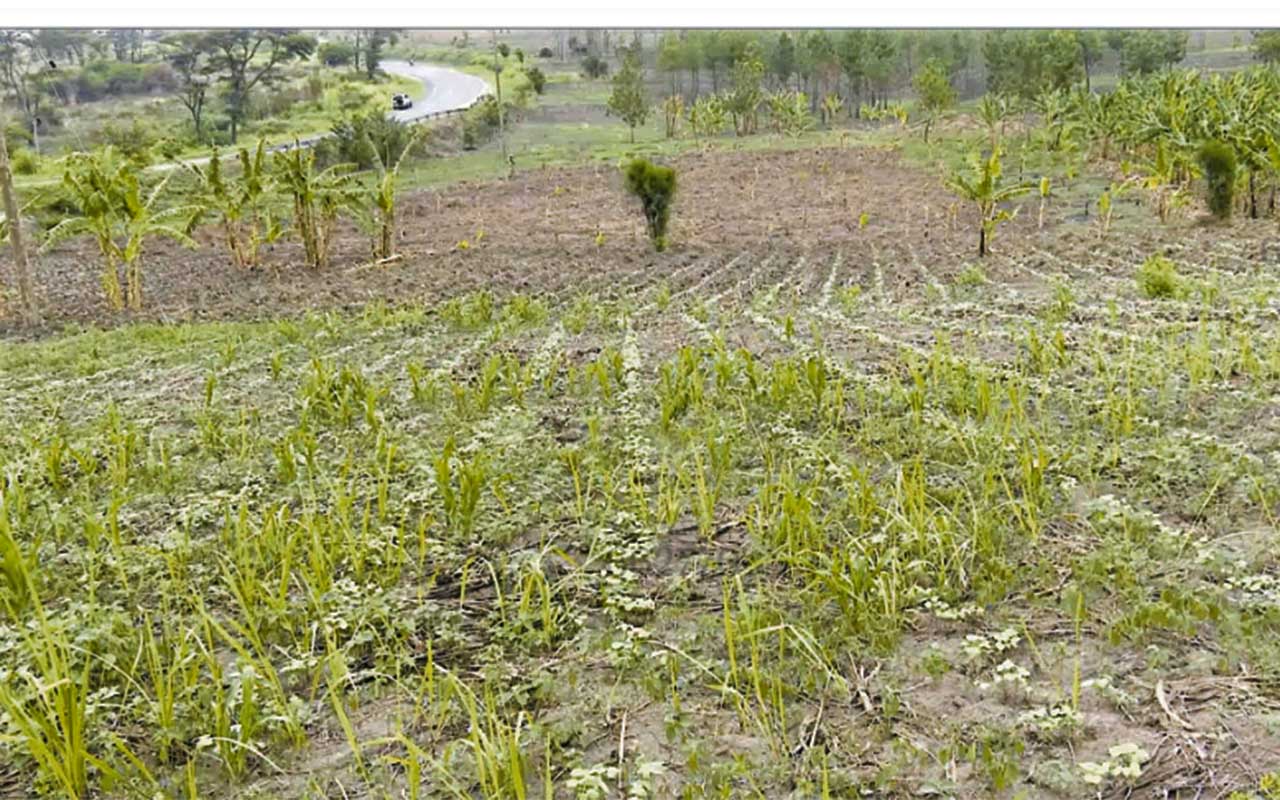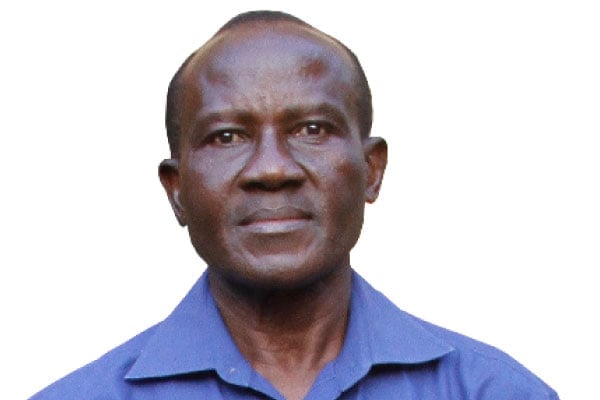Drought ruining Kasese farmers' livelihoods

Farm land prepared for the September rainy season. Twelve sub-counties in the district have been hit with drought and prolonged dry spells. PHOTO/COLLINS MUHWEZI
What you need to know:
- Kasese is one of the biggest districts in the country with 41 sub-counties. The sub-counties in the mountainous areas are recieving rainfall, as they should, sometimes causing disastrous floods. However, the sub-counties on the leeward side of the Rwenzori Mountains have faced persistent dry spells and drought for the last four years as Joan Salmon reports.
Along Bwera-Mpondwe road, in Kasese district, farmers till the land, with every hoe raising more dust than dirt, a testament of how hard the sun has scorched the ground. Located at the slopes of the Rwenzori Mountains, the low altitude leads to high temperatures as the district also sits on the Equator. In January this year, the average temperatures were 25.1 °C.

Gideon Bwambale walks through drying maize garden.
Today, the temperature is 28.6 °C. The most affected areas are low-lying sub-counties like Kahokya, Nyakatonzi and Muhokya.
High deforestation levels have also exposed the mountain slopes and tampered with rain formation. Twelve sub-counties in the district have been hit with drought and prolonged dry spells. The dried maize and banana plants on Gideon Bwambale’s quarter-acre garden, in Kahokya sub-county, could mean there was a harvest a few weeks ago. However, he is quick to share that they did not harvest a single cob.
“Before the cobs would form, the sun dried them. Indeed, the sun has defeated us this season. The situation has been the same for the last eight seasons (four years). We are waiting on the mercy of God to send us rain because we do not have an alternative source of livelihood,” he laments.
To mitigate the effects of the sun, Bwambale and his neighbours are now planting trees in the hope that the rains will come. Bwambale’s neighbour opted to grow cotton and beans, which are believed to be more drought resilient than other food crops.
However, his cotton garden speaks a sad story because although planted a month ago the cotton is stunted, looking like it is a week old. Kasese District has two rainy seasons – March to May and September to December, and there is hope that with the rains on the way, agriculture will pick up.
On the descent to River Nyamugasani, the situation is no different for Sam Nabugere, a mango farmer who started planting when it began drizzling in late August.
“I planted 400 mango trees on four acres, but now, a month later, half of the trees have died. The weather forecast indicated that we would get rain by September 15, but that has not happened. I believe I will only salvage about 100 mango trees,” he says.
Nabugere has eight acres of land but is now irrigating six of them to try and help his mango trees develop.
“My farm is about 500 metres from the river so I use a pickup truck to ferry 500 litres of water for irrigation. Every day, I spend Shs100,000 on watering the farm. My long term plan is to build a ground tank on the next hill to store water for irrigation,” he says.

Cattle keepers not spared
Among the Basongora community, who are mainly cattle keepers, up to 1,000 heads of cattle have been known to perish in some dry seasons.
Kenneth Muyambi, the vice chairperson of Muhumuza Cattle Keepers Cooperative Society in Nyakatonzi sub-county, says the government has constructed three valley dams – Kakogye 1, Kagongo and Kyasenda – to try and address the crisis.
“The valley dams have minimised cattle deaths as they facilitate a constant water supply, even in the dry season. The main source of water is rainfall and the Kyanyampara water canal. When the valley dams are full, the water can last for up to six months before it is used up,” he says.
However, the valley tanks were last full in January. Now, they are now dry. Each dam feeds about 40,000 heads of cattle from the three different communities.
“Since there is no rain, the valley dams are empty. The Kyanyampara water canal feeds a number of sub-counties. During the dry season, like this one, farmers build channels to divert the water to their farms for irrigation. This means the cattle keepers downstream are deprived of water,” Muyambi adds.
The community calls on the government to instead tap into River Nyamugasani and create a canal through which water can flow into the valley tanks.
“We thank the government for building the valley dams. But the dams need water. Besides channelling water from River Nyamugasani, we request the government to dig solar powered boreholes to pump water into the dams,” Muyambi says.
Tapping into River Nyamugasani will increase the milk production in the area to satisfy the available market around the Mpondwe-Rubiriha border. The cooperative society has 4,000 heads of cattle, but its milk production stands at 5,000 litres in the dry season and 15,000 litres in the rainy season.
The pastoralists say this can improve if the cattle is well watered.
Government response
Julius Rukara, the principal agricultural officer for Kasese district, says the sub-counties experiencing drought are on the leeward side of the Rwenzori Mountains.
“We used to have two rain seasons but because of climate change, the seasons are unpredictable. For instance, the second rain season of the year starts in September and ends in November, but right now there is no rain. In other parts of the country, people plant crops throughout the year. Our farmers struggle to plant crops but end up depending on the mercy of God,” he says.
The district has four rivers and lakes but the farming population is yet to adapt to irrigation. Rukara says the biggest challenge the district is facing is mind-set change.
“Many still view farming as a punishment rather than an opportunity, making it difficult to encourage sustainable practices like agroforestry. People need to be sensitised to understand why we have a drought and then be encouraged to adopt climate smart technologies. People also do not have enough land to plant trees. The population in Kasese now stands at one million,” he explains.
Kasese town has two irrigation schemes – Mobuku and Mobuku II – which can cover 4,000 acres. With support from the government and development partners, the district is constructing smaller irrigation schemes in different sub-counties to cover 100 to 200 acres.
“Additionally, under the UgIFT Micro-scale Irrigation project, some farmers in the dry corridor are being helped to procure irrigation equipment. About 45 micro-irrigation systems, that can irrigate one or two acres, will be set up for small-scale farmers by the end of September,” Rukara adds.
The Micro-scale Irrigation program, hosted by the Ministry of Water and Environment, supports farmers to purchase and use individual irrigation equipment. Cattle farmers in Kahokya are being advised to dig shallow underground wells to store water for irrigating their pasture and watering their animals.
Eliphaz Muhindi, the LCV chairperson of Kasese district, is optimistic about ongoing efforts to improve the situation, especially in the water distressed areas like Kahokya sub-county.
“With support from the Ministry of Water and Environment and the local government of Kasese, we are constructing a solar-powered borehole that will have six tap stands. Secondly, we are also constructing the Nyamugasani Gravity Flow Scheme, which will have two lines, one with 1,500 tap stands and the other with 2,000 tap stands,” he says.
Construction of the Nyamugasani Gravity Flow Scheme will cost Shs61 billion. The district has also allocated funds to sensitise farmers who are diverting water from Kyanyampara canal to rationalise it so that cattle farmers in Nyakatonzi can also benefit.
Rukare says the district is also urging farmers in Kahokya, Muhokya and Lake Katwe sub-counties who are far from fresh water to dig shallow wells.
Kasese’s population continues to grow and yet the arable land between the Rwenzori Mountains and QENP is limited. If the effects of a changing climate are not intentionally dealt with, matters can only worsen.





